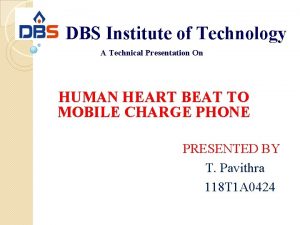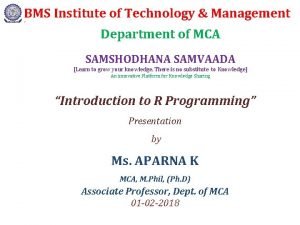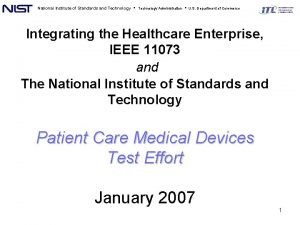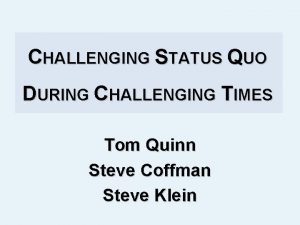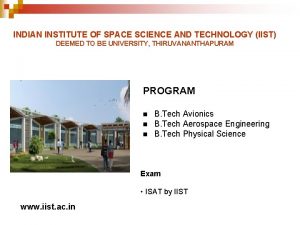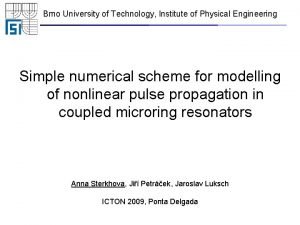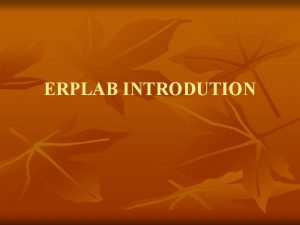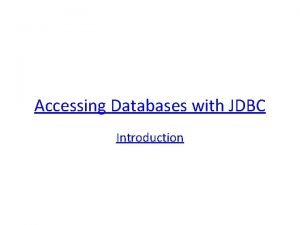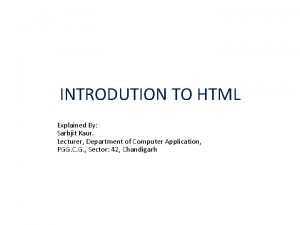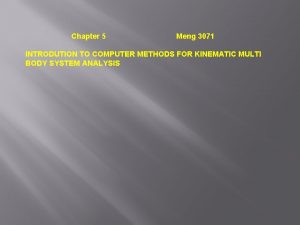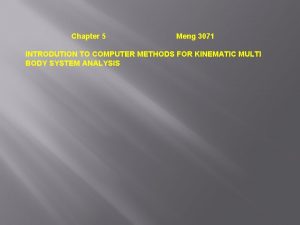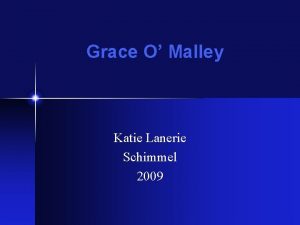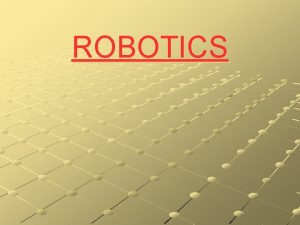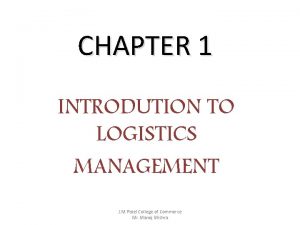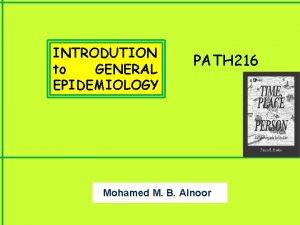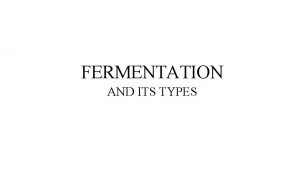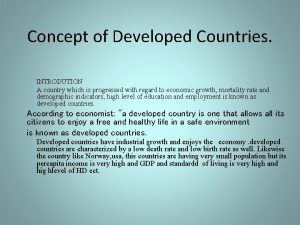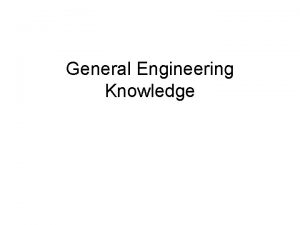KNOWLEDGE INSTITUTE OF TECHNOLOGY INTRODUTION TO COMMUNICATION ENGINEERING













![A 1. 2: Random Variable Since the event [X ≦ x] has to be A 1. 2: Random Variable Since the event [X ≦ x] has to be](https://slidetodoc.com/presentation_image_h2/7d320fd842194e9835948defd5f79cbf/image-14.jpg)













- Slides: 27

KNOWLEDGE INSTITUTE OF TECHNOLOGY INTRODUTION TO COMMUNICATION ENGINEERING PREPARED BY V. VIJITHA ASSISTANT PROESSOR/ECE

Chapter 1 Random Processes “Probabilities” is considered an important background to communication study.

1. 1 Mathematical Models To model a system mathematically is the basis of its analysis, either analytically or empirically. Two models are usually considered: Deterministic model No uncertainty about its time-dependent behavior at any instance of time. Random or stochastic model Uncertain about its time-dependent behavior at any instance of time, but certain on the statistical behavior at any instance of time. Chapter 1 -3

1. 1 Examples of Stochastic Models Channel noise and interference Source of information, such as voice Chapter 1 -4

A 1. 1: Relative Frequency How to determine the probability of “head appearance” for a coin? Answer: Relative frequency. Specifically, by carrying out n coin-tossing experiments, the relative frequency of head appearance is equal to Nn(A)/n, where Nn(A) is the number of head appearance in these n random experiments. Chapter 1 -5

A 1. 1: Relative Frequency Is relative frequency close to the true probability (of head appearance)? It could occur that 4 -out-of-10 tossing results are “head” for a fair coin! Can one guarantee that the true “head appearance probability” remains unchanged (i. e. , time-invariant) in each experiment (performed at different time instance)? Chapter 1 -6

A 1. 1: Relative Frequency Similarly, the previous question can be extended to “In a communication system, can we estimate the noise by repetitive measurements at consecutive but different time instance? ” Some assumptions on the statistical models are necessary! Chapter 1 -7

A 1. 1: Axioms of Probability Definition of a Probability System (S, F, P) (also named Probability Space) 1. Sample space S All possible outcomes (sample points) of the experiment 2. Event space F Subset of sample space, which can be probabilistically measured. F and S F A F and B F c A F implies A F. imply A f i B F. A F and B F imply A∪B F. 3. Probability measure P Chapter 1 -8

A 1. 1: Axioms of Probability 3. Probability measure P A probability measure satisfies: P(S) = 1 and P(Empty. Set) = 0 For any A in F, 0 ≦ P(A) ≦ 1. For any two mutually exclusive events A and B, P(A∪ B) = P(A) + P(B) 1. N n (S ) n and N n (empty. Set) 0. These Axioms coincide with the relative-frequency expectation. N n ( A) 1. n 3. N n ( A ! B) N n ( A) N n (B) 2. 0 Chapter 1 -9

A 1. 1: Axioms of Probability Example. Rolling a dice. S={ F = {Empy. Set, { P satisfies } }, { }, S} P(Empty. Set) = 0 P({ }) = 0. 4 P({ }) = 0. 6 P(S) = 1. Chapter 1 -10

A 1. 1: Properties from Axioms All the properties are induced from Axioms Example 1. P(Ac) = 1 – P(A). Proof. Since A and Ac are mutually exclusive events, P(A) + P(Ac) = P(A∪Ac) = P(S) = 1. Example 2. P(A∪B) = P(A) + P(B) – P(A∩B). Proof. P(A∪B) = P(A/B) + P(B/A) + P(A∩B) = [P(A/B) + P(A∩B)] + [P(B/A) + P(A∩B)] – P(A∩B) = P(A) + P(B) – P(A∩B). Chapter 1 -11

A 1. 1: Conditional Probability Definition of conditional probability P(B | A) N n ( A ! B) P( A) N n ( A) Independence of events P(B | A) P(B) A knowledge of occurrence of event A tells us no more about the probability of occurrence of event B than we knew without this knowledge. Hence, they are statistically independent. Chapter 1 -12

A 1. 2: Random Variable A probability system (S, F, P) can be “visualized” (or observed, or recorded) through a real-valued random variable X. After mapping the sample point in the sample space to a real number, the cumulative distribution function (cdf) can be defined as: X : S 1 2 3 4 5 6 FX ( x) Pr[ X x] P{s S : X (s) x} Chapter 1 -13
![A 1 2 Random Variable Since the event X x has to be A 1. 2: Random Variable Since the event [X ≦ x] has to be](https://slidetodoc.com/presentation_image_h2/7d320fd842194e9835948defd5f79cbf/image-14.jpg)
A 1. 2: Random Variable Since the event [X ≦ x] has to be probabilistically measurable for any real number x, the event space F must consist of all the elements of the form [X ≦ x]. In previous example, the event space F must contain the intersections and unions of the following 6 sets. }={s S: X(s)≦ 1} Otherwise, the cdf is { }={s S: X(s)≦ 2} not well-defined. { { }={s S: X(s)≦ 3} { }={s S: X(s)≦ 4} { }={s S: X(s)≦ 5} { }={s S: X(s)≦ 6} Chapter 1 -14

A 1. 2: Random Variable It can be proved that we can construct a welldefined probability system (S, F, P) for any random variable X and its cdf FX. So to define a real-valued random variable by its cdf is good enough from engineering standpoint. In other words, it is not necessary to mention the probability system (S, F, P) before defining a random variable. Chapter 1 -15

A 1. 2: Random Variable It can be proved that any function satisfying: 1. lim G(x) 0 and lim G(x) 1. x x 2. Right- continuous. 3. Non-decreasing. is a legitimate cdf for some random variable. It suffices to check the above three properties for FX(x) to well-define a random variable. Chapter 1 -16

A 1. 2: Random Variable A non-negative function f. X(x) satisfies Pr( X x) x f X (t)dt is called the probability density function (pdf) of random variable X. If the pdf of X exists, then FX ( x) f X ( x) x Chapter 1 -17

A 1. 2: Random Variable It is not necessarily true that If FX ( x) f X ( x) , x then the pdf of X exists and equals f. X(x). Chapter 1 -18

A 1. 2: Random Vector We can extend a random variable to a (multidimensional) random vector. For two random variables X and Y, the joint cdf is defined as: FX , Y ( x, y) Pr( X x and Y y) P({s S : X (s) x } {s S : Y (s) y }) Again, the event [X ≦ x and Y ≦ y] must be probabilistically measurable in some probability system (S, F, P) for any real numbers x and y. Chapter 1 -19

A 1. 2: Random Vector As continuing from previous example, the event space F must contain the intersections and unions of the following 4 sets. ( X , Y ) : S (1, 1) (2, 1) (1, 1) (2, 2) (1, 2) (2, 2) { }={s S : X(s)≦ 1 and Y(s)≦ 1} { }={s S : X(s)≦ 2 and Y(s)≦ 1} { }={s S : X(s)≦ 1 and Y(s)≦ 2} { }={s S : X(s)≦ 2 and Y(s)≦ 2} Chapter 1 -20

A 1. 2: Random Vector If its joint density f. X, Y(x, y) exists, then f X , Y ( x , y) = 2 @F X , Y (x, y) @x @y The conditional density function of Y given that [X = x] is f Y | X (y|x) = f X , Y (x, y) f X (x) provided that f. X(x) 0. Chapter 1 -21

1. 2 Random Process Random process: An extension of multidimensional random vectors Representation of two-dimensional random vector (X, Y) = (X(1), X(2)) = {X(j), j I}, where the index set I equals {1, 2}. Representation of m-dimensional random vector {X(j), j I}, where the index set I equals {1, 2, …, m}. Chapter 1 -22

1. 2 Random Process How about {X(t), t }? It is no longer a random vector since the index set is continuous! This is a suitable model for, e. g. , a noise because a noise often exists continuously in time. Its cdf is well-defined through the mapping: X (t) : S for every t . Chapter 1 -23

Define, or view, a random process via its inherited probability system Sample Space S X(t, s 1) outcome corresponding to the first sample s 1 t X(t, s 2) s 2 t X(t, s 3) s 3 t X(t, s 4) s 4 t X(t, s 5) s 5 t X(t, s 6) s 6 t Chapter 1 -24

1. 2 Random Process X(t, sj) is called a sample function (or a realization) of the random process for sample point sj. X(t, sj) is deterministic. Chapter 1 -25

1. 2 Random Process Notably, with a probability system (S, F, P) over which the random process is defined, any finite-dimensional joint cdf is well-defined. For example, Pr X (t 1 ) x 1 and X (t 2 ) x 2 and X (t 3 ) x 3 P s S : X (t 1 , s) x 1 s S : X (t 2 , s) x 2 s S : X (t 3, s) x 3 Chapter 1 -26

1. 2 Random Process Summary A random variable maps s to a real number. A random vector maps s to a multi-dimensional real vector. A random process maps s to a real-valued deterministic function. s is where the probability is truly defined; yet the image of the mapping is what we can observe, manipulate and experiment over. Chapter 1 -27
 Vidhyadeep institute of engineering and technology
Vidhyadeep institute of engineering and technology Reel to reel institute
Reel to reel institute Mandava institute of engineering and technology
Mandava institute of engineering and technology Stevens institute of technology mechanical engineering
Stevens institute of technology mechanical engineering Calc institute of technology
Calc institute of technology Waterford institute of technology vacancies
Waterford institute of technology vacancies Unist application fee
Unist application fee Assistive technology implementation plan
Assistive technology implementation plan Masdar institute of science and technology
Masdar institute of science and technology Madhav institute of technology and science
Madhav institute of technology and science Grenoble institute of engineering
Grenoble institute of engineering Gastechnology
Gastechnology Aperture stop
Aperture stop Dbs institute of technology
Dbs institute of technology Materials technology institute
Materials technology institute Bms institute of technology & management
Bms institute of technology & management Vocational education uae
Vocational education uae Sri lanka institute of information technology
Sri lanka institute of information technology Sagar institute of research and technology
Sagar institute of research and technology Prajnanananda institute of technology
Prajnanananda institute of technology National institute of standards and technology
National institute of standards and technology Monohakobi technology institute
Monohakobi technology institute Schorarly
Schorarly Netherlands maritime institute of technology (nmit)
Netherlands maritime institute of technology (nmit) Stevens institute of technology
Stevens institute of technology Kth royal institute of technology notable alumni
Kth royal institute of technology notable alumni Iist pune
Iist pune Brno institute of technology
Brno institute of technology













